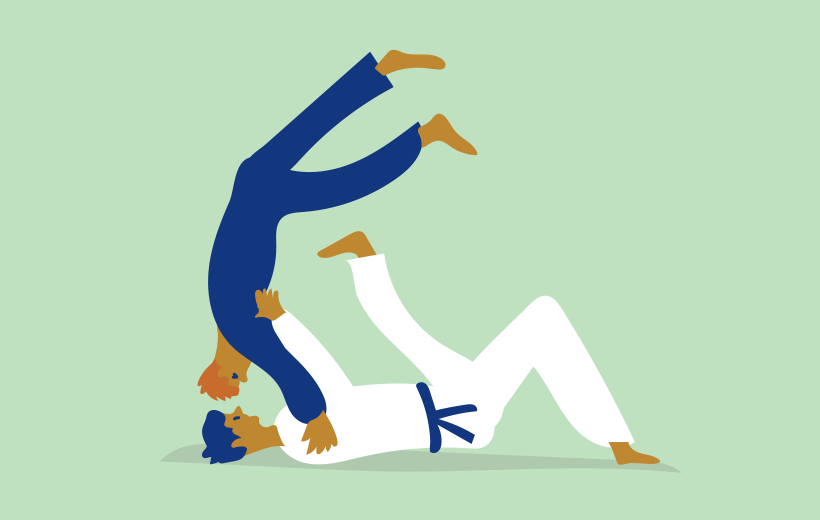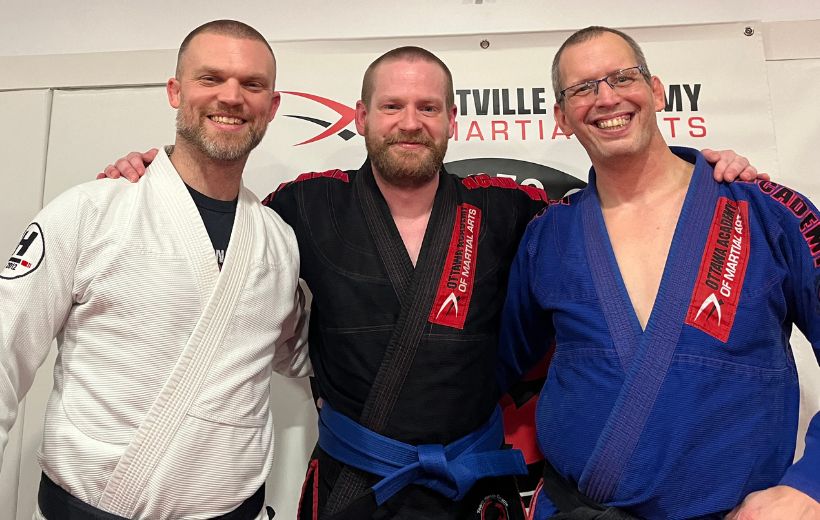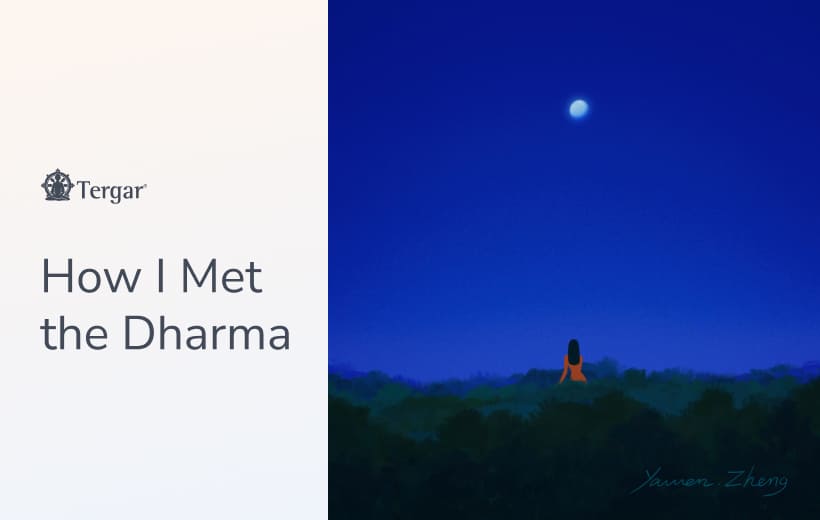Meditation on the Mat: Lessons from Brazilian Jiu Jitsu
By Justin Ralph • 4 min read
By Justin Ralph • 4 min read

ONE CRISP OCTOBER AFTERNOON, my young son and I joined a Halloween community event in our small rural town. As we wandered through local businesses offering candy, we stumbled into a tiny Brazilian Jiu Jitsu (BJJ) studio. Inside, two large, sweaty men grappled on the mats while a smiling black belt in a skeleton costume handed my son a lollipop. He barely noticed the candy — he was completely enthralled by the two men rolling and maneuvering, their movements a mysterious dance of power and skill.
A few weeks later, my son stepped onto that very same mat in a pristine — and very small — gi, launching his BJJ journey. Soon afterward, fueled by equal parts excitement and trepidation, I followed suit. I, too, found myself facing my own fears on those mats.
FACING FEAR
My apprehension came from two primary sources. The first was physical. I’m not a naturally gifted athlete, nor particularly strong or imposing. The idea of being pinned beneath a 250-pound training partner was not especially appealing to me. The second source of fear was more subtle: it was spiritual. I was deeply immersed in meditation practice and the teachings Mingyur Rinpoche shares in the Joy of Living. Was there a fundamental conflict between cultivating awareness and compassion and learning a martial art — something that, at its core, involves techniques designed to cause discomfort and potentially harm?
Years later, and after a long pause during the pandemic, I now see my parallel paths of meditation and martial arts as profoundly synergistic. My meditation practice has helped me become a better BJJ practitioner, and the challenges on the mat have, in turn, strengthened both my meditation and my understanding of the teachings. Far from undermining each other, these two paths support and enrich one another.

Professor Matt “Hammer” Hache, Justin Ralph and Professor Tad Black (Justin’s instructor); Matt awarded Justin his blue belt
BUILDING RESILIENCE
When we sit down to meditate, the experience is not always calm or blissful. Sometimes, our minds churn with negative thoughts, our bodies ache, and our surroundings bristle with distractions. Over time, however, we learn to befriend these difficulties and see them as part of the path. Instead of resisting discomfort, we notice it, acknowledge it, and relax into it. Eventually, we find a space within awareness that makes even painful experiences more workable.
This same principle applies to the jiu jitsu mat. Learning to remain aware when someone’s weight restricts your breathing, or they secure an arm lock is no small feat. My meditation practice helps me to relax into these challenging situations. Rather than panicking or fighting blindly, I find a way to remain present and breathe. In turn, facing these physical challenges in BJJ allows me to remain more stable and open when I’m sitting on the cushion. Discomfort — whether emotional or physical — becomes less threatening and more manageable in both arenas.
TAKING THE LONG ROAD
Early in my meditation practice, I found Mingyur Rinpoche’s advice about measuring progress over the long term especially supportive. He reminds us that growth may not be noticeable day to day, but if we look back over months and years, we often see remarkable improvement. This perspective helps us navigate the ups and downs of the spiritual path without becoming discouraged.
BJJ shares this slow-burn approach to progress. It’s a notoriously challenging art that has a very steep learning curve. In the world of jiu jitsu, it’s often said that the only difference between a white belt and a black belt is that the black belt never gave up. Inspired by Rinpoche’s teachings and my BJJ instructor’s advice, I’ve learned to view my jiu jitsu journey the same way: not as a linear road but as a winding path where perseverance and steadiness matter more than short-term gains. Over time, I see how much I’ve learned — not just in techniques but in patience and resilience.
YOGIC CONDUCT AND FEARLESSNESS
In the nature of mind traditions Mingyur Rinpoche teaches from, there is an emphasis on “taking the fruition as the path.” This means recognizing that we already possess the inherent qualities of awareness, compassion, and wisdom. We are, at our core, fundamentally complete. The practice is to learn to see this wholeness and, over time, to be able to rest in the natural state of awareness regardless of circumstance.
In the past, Dzogchen and Mahamudra practitioners tested their understanding of this view by putting themselves in difficult or frightening situations. The fearlessness they displayed in facing adversity with stability and equanimity is sometimes known as “yogic conduct.”
This notion of yogic conduct resonates deeply with my experience of BJJ. Training on the mat becomes a way to test my connection to awareness beyond the meditation cushion. The initial spike of anxiety when I see a larger, more skilled opponent approach, the intense sensations during a tough throw, or the sting of a loss — all of these give me opportunities to apply the awareness, compassion, and stability I work to cultivate in meditation. In feeling fear and not running from it, in accepting loss without losing heart, I learn how to rest more fully in my own natural awareness.
INTEGRATING PRACTICE AND LIFE
As I continue to weave together my meditation practice and my jiu jitsu training, I see that they are not separate pursuits. Both involve engaging with challenges, uncertainty, and discomfort — not to escape them, but to learn from them. Both demand patience, curiosity, and perseverance. And both remind me that true fearlessness is not about the absence of fear but about embracing it as part of the journey.
In the end, practicing meditation and stepping onto the BJJ mat serve the same purpose: to wake up to who we truly are. The lessons of awareness, resilience, and courage travel back and forth between these two worlds, enriching both. And in that exchange, I discover that what I learn on the cushion makes me stronger on the mat, and what I learn on the mat makes me more open and stable on the cushion. Each path shines light on the other, guiding me toward greater understanding, fearlessness, and joy.
January 2025

Justin Ralph is the Chief Content Officer at Tergar International and helps support the development of curriculum, video, and audio for Tergar’s programs. He is based out of rural Ontario, Canada, not far from Ottawa.
Learn meditation under the skillful guidance of world-renowned teacher Yongey Mingyur Rinpoche at your own pace.


French humanitarian Margot Clavier leads sustainable development projects at 11,800 feet in remote Himalayan village Samagaun, helping locals create income through innovative initiatives while preserving their environment and cultural identity.

Paulo Carvalho shares the journey of how he met the dharma and discovered the path that pointed inward.

“I have had such a different mindset since I began practicing meditation. I didn’t believe in the power of meditation at first, but now I’m amazed by it — it’s real. I’ve really come to see the benefits of meditation!” – Yuki Kameda
If you enjoyed reading our articles, please join our mailing list and we’ll send you our news and latest pieces.